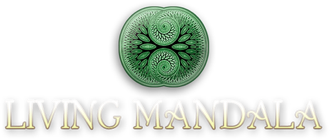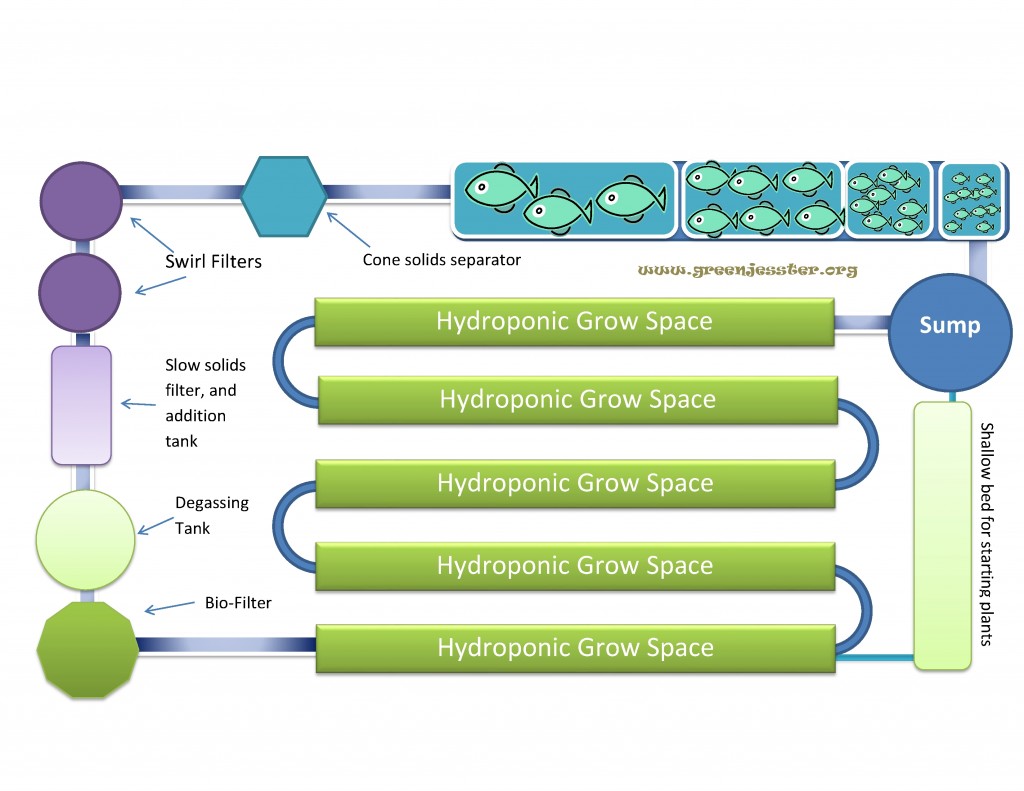It is becoming necessary to consider the inputs and outputs of our production systems. As resources become more expensive and less available, our designs need to be more efficient. Bi-products need to be seen as valuable resources and reused or repurposed as many times as possible. Our food production systems are no exception. Food cannot be grown in isolation, nutrients have to be provided and plant wastes have to be disposed of. Food production systems such as Aquaponics can be incorporated into sustainable closed loop systems.
In an aquaponics system the interactions between the basic three components are easy to understand. The fish produce wastes which are broken down by bacteria; the bi-products of this process are available nutrients which are utilized by the plants grown in the system. These plants can include vegetables, fruiting plants, rice, grains, herbs and medicinal herbs. In this type of system many of nutrients are lost, as well requiring a lot of outside inputs. Input of nutrients such as fish food and water additives, for plants, has to originate from outside the system. They have to be manufactured, processed, shipped and purchased before these inputs can become part of the nutrient cycle. Wastes from this system include plant matter, fish solids, and leftover fish parts. There are many different ways that fish production can become a closed loop system; by developing systems to utilize principals of biomimicry; reproducing natural plant and animal relationships in our food system designs.
The next step is find a way to utilize wastes from this system. Decaying unusable plant matter, including the root mass can be reused in a few different ways. Some fish will nibble certain plants, retaining the nutrients in the system. One of the problems with feeding fish vegetable scraps is that large pieces of plant matter settling on the bottom can start anaerobic processes which cause ammonia spikes. Chickens could also be included in this food production system. Chickens really like leafy greens; they could also be used to retain some of the nutrients in this cycle. The remaining plant matter they discard or won’t consume can be composted.
Plant matter can be composted three main ways. Plant matter can be composted in the normal pile fashion and later used as a soil additive. Plants and food scraps can be broken down by worms; this is referred to as vermiculture. Red worms are grown in bins and fed food scraps; they do an amazing job at breaking down these plant wastes. The red worms are prolific and will multiply quite quickly in the bins; these worms can then be fed to fish or chickens. The worm poop, also known as castings is held at high value in horticulture as a soil additive. Compost tea or Vermi-tea is a liquid produced during the breakdown of plant and food wastes which is high in nutrients and microbial activity. This compost tea can be used as a soil additive, sometimes added back into the aquaponics system or sold.
Another option is Black Soldier Flies, Hermetia illucens, referred to as BSF. BSF larvae are basically eating machines, they are amazing living composters. They do a job similar to red worms but can break down waste products worms cannot handle. Hard to break down nutrient rich wastes including; fish, chicken, swine, and cattle manures can be consumed and broken down by these heavy feeders. Black fly larvae have shown in studies that they “reduce the nutrient concentration and bulk of the manure residue, thus reducing pollution potential 50-60% or more.” (Williams 2005) BSF cultivation has potential in other areas of food production dealing with wastes. BSF larvae can also consume meat. In an aquaponics system they could be utilized to process dead fish, as well as used to breakdown the fish remains after harvesting. When these BSF larvae reach the most nutrient rich and fat stores of their life cycle they self-harvest and separate themselves from the rest of the colony. This makes collecting them an easy process. These little digestion machines are great protein and fat source for other components of our food production system. They can be fed to chickens as well as fish. They can be frozen for later use as well as ground and processed into a component in fish food. They can even be processed to separate the oils fats to create biodiesel, even after the oil is extracted the remaining matter can still be used as a major component in fish food.
After the Black Soldier Fly larvae process the compost, the remainders can be put into a vermiculture system. Wastes that normally would be toxic to the red worms can now be safely be broken down by the worms. This is just another step in making this a closed loop system, BSF larvae breakdown wastes that are later fed to worms, this one link in the system produces Black Fly Larvae and worms, both which can be fed to chickens and fish. In addition this step produces soil additives and helps cut down on wastes produced.
The other fish food that can be grown quite readily is duckweed. It is fast growing, easy to cultivate. Since it floats on the surface of the water it is easy to harvest with a net. One component in an aquaponics set up is a settling tank. Solids are left in culture water to allow for more mineralization to occur. Using one of these tanks duckweed can be grown and harvested and the nutrients returned to the fish. Duckweed alone is not a good fish feed but when combined with the fat and protein from BSF, it can become another way to keep nutrients in the loop.
In this system chickens would be eating left over greens from the floating grow beds, sharing BSF and red worms with the fish, and then producing eggs and manure. The manure will be turned into BSF food, then vermi-food, then into a soil additive. After the eggs have been eaten the shells are returned to the system and added to one of the filter tanks to slowly leech calcium into the system. Another link in the aquaponic cycle is calcium, normally added to an aquaponics setup to help foster plant growth. Calcium can be added through prepared mixtures or by adding oyster shells or egg shells. Using egg shell closes one more loop in the system.
Observing systems already in place in the natural world provides insight into how to design sustainable food production systems. As in this example; growing food including fish, chickens, eggs, fruit and vegetables can all be part of one system which mimics natural processes. Each part of the system helps to maintain another portion of the cycle, each able to flourish because of the support of the other system components. This type of design approach needs to be used in all areas of our production and consumption. This type of system is just one way to approach sustainability.





















